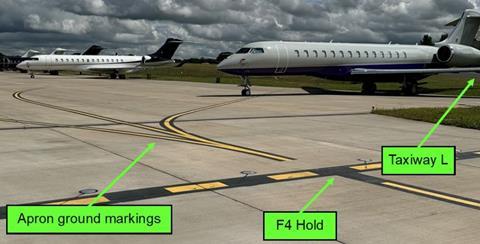Jet blast from an incorrectly-parked Bombardier Global 6000 executive jet damaged a taxiing vintage Piper Cub light aircraft at Biggin Hill, UK investigators have determined.
The Cub had been taxiing past an apron which was not fitted with jet efflux attenuation barriers, owing to there being limited room between the apron and the taxiway.
Under an agreement between the airport and the maintenance organisation which used the apron, line markings would be installed for aircraft movement, and aircraft would be parked in alignment with these markings to redirect efflux.
But the Global 6000 (M-SFPL) had instead been parked perpendicular to the taxiway before the occurrence on 26 June last year.
The pilot of the Cub – which had been built in 1943 – was unaware that the jet had started its engines, as part of a wing anti-ice test, before he taxied behind it.

According to the UK Air Accidents Investigation Branch, the Cub “aggressively” ground-looped and weathercocked clockwise into the jet blast.
“For several seconds they experienced ‘total uncontrollability’ which resulted in the aircraft’s left wing-tip striking the ground on at least two occasions,” it adds.
An emergency was declared to air traffic control and the Cub’s occupants exited the aircraft in a bid to hold it down, before moving it away from the blast zone. Neither the Cub pilot nor the passenger was injured, but the aircraft sustained wing-tip damage.
Internal assessment by the maintenance organisation found that a degree of “normative” practice resulted in aircraft being parked in a way that reduced the area available to park them in line with the ground markings.
“Had any of the pilots involved been aware of the risk posed at that time to [the Cub] by the [Global 6000’s] jet efflux the confliction could likely have been avoided by mutual co-ordination over the radio,” states the inquiry. It adds that the maintenance organisation has since highlighted the importance of ensuring correct alignment of parked aircraft before engine start.


























